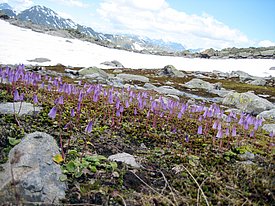
Plant ecology and biodiversity ¶
Mountain ecosystems are biodiversity hotspots, providing habitats for numerous specialised fauna and flora that occur nowhere else. We are investigating why and by how much plant diversity in the mountains is changing – not least as a result of climate change.
Alpine areas – which are naturally treeless – occupy roughly one quarter of Switzerland. Despite the inhospitable climate at these altitudes, around 20% of all Swiss flowering plant species grow there. This is tremendous diversity, bearing in mind that extensive areas above the tree line are permanently covered by ice and rock.
So how come we find such diversity there? Well, Alpine plants are specialists in survival under extreme environmental conditions, such as cold, intense sunshine or strong wind. Furthermore, different types of rocks and a complex topography create a mosaic of small habitats, where microclimates, snow cover, wind exposure and soil properties can all change within a very small area.
Alpine plant diversity reacts particularly sensitively when land use or the climate changes – not least because the climate in Alpine and Arctic regions is heating up faster than in many other ecosystems. We are investigating the links between changes in the environment, snow and vegetation, so that our findings can help us predict which species are particularly susceptible to climate change.
